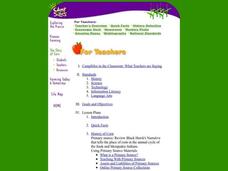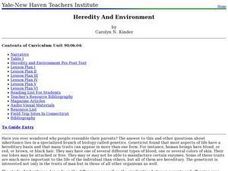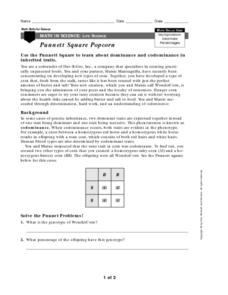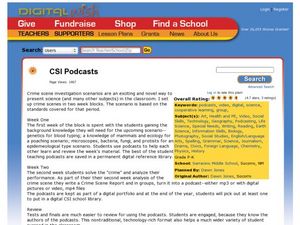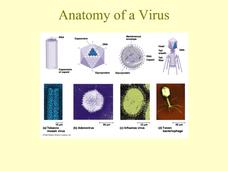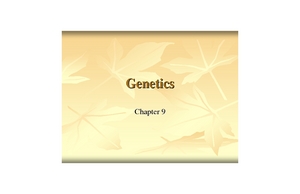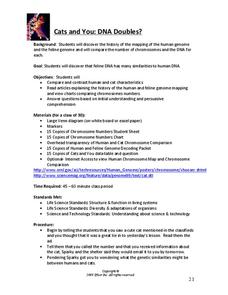Curated OER
The Story of Corn
Students use primary sources to compare the early development of corn with current techniques of biotechnology and genetically engineered seeds, and identify plants natural to the Americas and those natural to Europe that were part of...
Curated OER
How Evolution Works
High schoolers discuss the evolution of the eye and how a complex organ can evolve through natural selection. They research genetic variation, adaptation, and sexual selection. They analyze data to determine how beak length of Gal??pagos...
Curated OER
What is the purpose of Karyotyping?
High schoolers explain how karyotyping is used to diagnose specific genetic disorders. They use karyotypes to make observations and analyze chromosomal errors. This activity can be completed online or without computer access.
Curated OER
The Cell
Students study the basic processes by which cells divide and transfer their genetic information. They recognize and distinguish possible inherited traits and through the discovery method of the facts and principles of inheritance. this...
Curated OER
Heredity And Environment
Students complete a pre-test on the relationship between heredity and the environment. As a class, they write down descriptions of themselves and identify which traits can be changed and not changed. In groups, they determine which genes...
Curated OER
The Spanish Omelet
Students use analogies to show the relationships among cell, nucleus, genes, chromosome, ribosome, replication, mitosis, transcription, translation, DNA, RNA, amino acids and proteins, genotype, phenotype, and genetics vs. environmental...
Curated OER
Why Do People Fall in Love?
Students discuss human behavior, sexual selection and the underlying genetic and evolutionary reasons for mate selection. The, in groups, they rate the attractiveness of certain individuals and measure facial features for symmetry.
Curated OER
What's For Dinner?
Students share their own views on eating genetically altered foods. After reading an article, they research any issues concerning these types of foods in the United States. In groups, they create a campaign slogan to help gain funding...
Curated OER
Punnett Square Popcorn
In this genetics worksheet, students use the Punnett Square to learn about dominance and codominance in inherited traits. This worksheet has 1 short answer question and 6 problems to solve.
Curated OER
CSI Podcasts
Learners investigate crime scene scenarios to meet standards. In this crime scene scenario instructional activity, students gather background information during the first week. They investigate topics such as mammals, genetics, bacteria,...
Curated OER
Anatomy of a Virus
This PowerPoint summarizes details about the virus from the structure and reproduction methods to the different modes of infection. Various viral diseases of animals and plants, viroids, prions and genetic origins of viruses are discussed.
Curated OER
Heredity Worksheet #1
In this genetics worksheet, students review the experiments on pea plants that Mendel used to explain dominant and recessive alleles. This worksheet has 10 fill in the blank questions.
Curated OER
Heredity Worksheet #4
In this genetics worksheet, students use a pedigree to determine if any of the offspring carry a recessive trait. This worksheet has 5 fill in the blank and 5 short answer questions.
Curated OER
The Meaning of Genetic Variation
Students investigate variation in the beta globin gene by identifying base changes that do and do not alter function, and by using several Internet-based resources to consider the significance in different environments of the base...
Curated OER
Human Genetics Acrostic Poem
In this science worksheet, students demonstrate what they know about DNA and genes by writing acrostic poems. The vertical format is prepared on this page for students. There is no information on the page.
Curated OER
Genetics
Students identify literary elements in each selection while learning about diversity and the struggle for equality in the United States. They use their knowledge to express the emotion and key literary elements in each piece through...
Curated OER
Biotechnology
Students analyze the iimpact of biotechnology. They discuss genetically altered foods and the term biotechnology. They research websites and discuss terms related to genes, cells, DNA, and cloning. They write reports to investigate...
Curated OER
AP: Chapter 16: The Molecular Basis of Inheritance
Advanced biology masters take a close look at DNA and the scientists who contributed to our understanding of this complex and powerful molecule. They answer 21 questions about DNA structure, replication, and repair. This can be used as a...
Curated OER
Teaching Biology Through Bioinformatics
Learn more about the processes assisted by Bioinformatic Tools. Your class will learn how to research primary biological databases and the complex data that can be analyzed and manipulated to provide information. This information will...
Howard Hughes Medical Institute
Using DNA to Trace Human Migration
Can scientists trace all humans back to a small region in Africa? An intriguing lesson turns back time to reveal artifacts leading scientists to believe human life originated in Africa and dispersed from there.
Howard Hughes Medical Institute
Structure and Function of Telomeres
Curing cancer or finding the fountain of youth—the answer may be understanding the structure and function of telomeres. The relationship of telomeres to both aging and cancer have triggered aggressive research. A thorough lesson...
Howard Hughes Medical Institute
RNA Diversity
Messenger RNA, transfer RNA, and ribozymes ... the many faces of RNA. The structure of RNA makes it much more versatile than the very similar DNA. Learners view a slideshow presentation to learn all about the different forms and...
Beyond Benign
Cats and You: DNA Doubles?
What do cats and human DNA have in common? The second lesson of a series focuses on the mapping of mammal genomes. Scholars learn about the structure of DNA as they compare the chromosomes of humans and felines.
Howard Hughes Medical Institute
Developing an Explanation for Mouse Fur Color
Whether or not you think mice are nice, you'll love the colorful activity! Scholars examine evidence for evolution in the rock pocket mouse through video, discussion, and collaborative work. Learners watch a video regarding variation in...
Other popular searches
- Genetic Engineering
- Genetic Diseases
- Population Genetics
- Genetics Worksheets
- Mendelian Genetics
- Genetics Middle School
- Genetics Probability
- Genetic Traits
- Genetics & Punnett Squares
- Genetics and Heredity
- Genetic Mutations
- Genetic Drift


